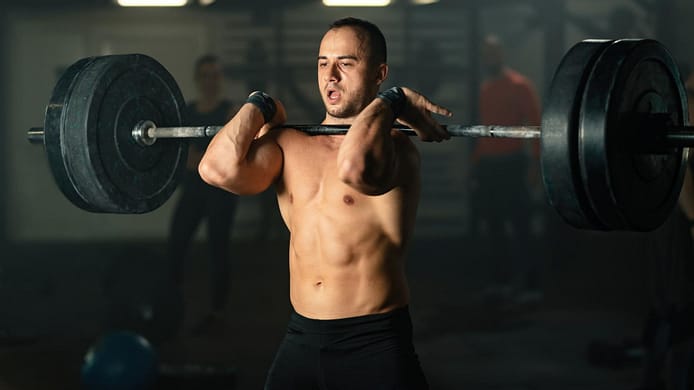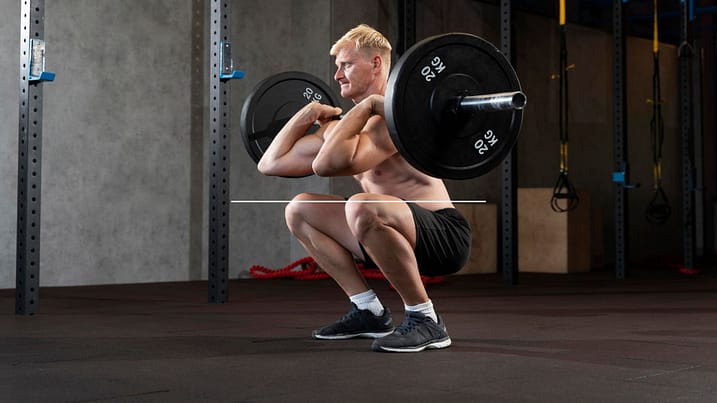Table of Contents
ToggleThe Link Between Squats and Tennis Performance
Squats are a cornerstone of many athletes’ training routines due to their ability to strengthen lower body muscles, enhance stability, and improve overall athletic performance. For tennis players, squat variations can target key muscle groups crucial for swift movement, powerful shots, and injury prevention.
Selecting the Best Squat Variation
Several squat variations can benefit tennis players, but the front squat stands out as an excellent choice for enhancing tennis-specific skills and performance.

Why the Front Squat?
Core Activation: The front squat places greater emphasis on core engagement compared to back squats. This is essential for tennis players as a strong core facilitates better stability and rotational power during shots.
Improved Posture: Tennis involves constant changes in direction and quick, explosive movements. Front squats promote better posture, aiding in the maintenance of an upright torso, which is crucial for optimal movement on the court.
Targeting Quads: This variation places more emphasis on the quadriceps, essential for explosive movements and quick changes in direction during matches.
How to Perform the Front Squat:
Positioning: Rest a barbell across the front of your shoulders, keeping elbows high and chest up.
Stance: Stand with feet shoulder-width apart or slightly wider.
Execution: Lower into a squat by bending at the hips and knees, ensuring knees track over toes.

Rise: Drive through the heels to return to the starting position, keeping core engaged throughout.
Additional Considerations:
While the front squat is highly beneficial, incorporating a variety of squat variations in your training routine can further enhance overall lower body strength and stability. Varieties such as goblet squats, Bulgarian split squats, or overhead squats can complement the benefits of the front squat.
So.
Incorporating front squats into your training regimen can significantly improve your tennis performance by enhancing core strength, stability, and lower body power. However, it’s essential to consult a fitness professional or coach to ensure proper form and individualized training programs.
Maximizing Tennis Performance: A Holistic Approach
When aiming to elevate your tennis game, optimizing performance isn’t solely about specific exercises; it involves a comprehensive strategy encompassing various facets of fitness and skill development.
Beyond Squats: Comprehensive Training for Tennis Players
Cardiovascular Conditioning: Tennis demands endurance. Incorporate cardiovascular exercises like sprints, interval training, or cycling to improve stamina and match readiness.
Agility and Footwork: Tennis is about swift movements and quick changes in direction. Agility drills, ladder exercises, and cone drills can enhance footwork, crucial for on-court agility.
Flexibility and Mobility: Ensure a dynamic warm-up routine and include stretching exercises to maintain flexibility and prevent injuries commonly associated with the sport.
Skill-Specific Training: Work on stroke mechanics, serve accuracy, and court positioning through regular practice sessions and drills.
Rest and Recovery: Adequate rest is as crucial as training. Allow time for recovery to prevent burnout and reduce the risk of overuse injuries.
Tailoring Squat Variations to Your Needs
While the front squat offers significant benefits, individual differences matter. Consider factors such as existing injuries, fitness level, and personal preferences when selecting squat variations. Consulting a fitness expert or a tennis coach can help personalize your training regimen for maximum effectiveness.
Balancing Training Components
Integrating squat variations into a well-rounded training routine is essential. Strive for balance by combining strength training, cardiovascular workouts, skill-focused practices, and ample rest for optimal performance enhancement.
Conclusion:
Squat variations, especially the front squat, play a pivotal role in enhancing lower body strength and stability for tennis players. However, a holistic approach to training, encompassing various aspects of fitness and skill development, is essential for maximizing tennis performance on the court.
Remember, consistency, proper technique, and a comprehensive training plan tailored to individual needs can significantly impact your tennis game and overall athletic performance.
External Resources:
For further insights into optimizing your tennis performance through strength training, check out these valuable resources:
USTA – Strength and Conditioning for Tennis Players
TennisFitness.com – Squat Variations for Tennis Players
Tennis.com – Strength Training for Tennis Players
Remember, a well-rounded training program, including specific squat variations, can be a game-changer in enhancing your tennis skills and performance on the court.
Enhancing your tennis performance goes beyond a single exercise; it’s about adopting a holistic approach that combines strength, agility, skill, and recovery for an all-encompassing boost on the court.
Comparison tabular
| Squat Variation | Key Benefits | Muscles Targeted | Execution |
|---|---|---|---|
| Front Squat | – Increased core activation for stability
– Improved posture – Targeted focus on quadriceps |
Quadriceps, core, glutes | Rest barbell across front shoulders, feet shoulder-width apart, lower into squat, drive through heels |
| Goblet Squat | – Enhanced mobility and posture
– Core engagement |
Quadriceps, glutes, core | Hold dumbbell/kettlebell at chest, squat down, maintain upright position |
| Bulgarian Split Squat | – Improved balance and unilateral strength
– Hip mobility |
Quadriceps, hamstrings, glutes, stabilizing muscles | Place one foot elevated behind, lower body into lunge position, return to standing |
| Overhead Squat | – Enhanced shoulder mobility and stability
– Full-body engagement |
Quadriceps, glutes, core, shoulders, upper back | Hold barbell overhead, feet shoulder-width apart, squat down while keeping arms extended |
These squat variations offer distinct benefits, targeting various muscle groups and aspects of athletic performance crucial for tennis players. Incorporating a combination of these variations into a training routine can provide a well-rounded approach to enhancing on-court performance.
Wrapping up
In the realm of tennis performance enhancement, squat variations like the front squat stand as pillars for strength, stability, and agility. While the front squat shines in its ability to fortify core strength and amplify lower body power, it’s just one piece of the larger puzzle.
Remember, tennis excellence isn’t sculpted by a single exercise. It’s an intricate masterpiece, woven from diverse threads of agility drills, skill honing, cardiovascular endurance, and targeted strength training.
Craft your training regimen like an artist, embracing a palette of squat variations front squats, goblet squats, Bulgarian split squats, and overhead squats to paint a canvas of dynamic strength and agility. Tailor your approach, consult experts, and fuse these exercises into a symphony of fitness, refining not just your squats but your overall performance on the court.
So, lace up your sneakers, grip your racket, and embark on this journey with a holistic vision. Blend the power of squats with agility drills, skill practice, and mindful recovery to unlock your true potential on the tennis court. Elevate your game, one squat at a time, and stride towards becoming a force to reckon with on the courts.
In the pursuit of excellence, let versatility and dedication be your allies, propelling you towards the zenith of your tennis prowess.

Hey there, it’s Mike Rrsq, the Editor-in-Chief over at Jsquat.com, and I’m absolutely obsessed with all things squat fitness! I’ve been lucky enough to get some serious recognition for my work in this field. With a solid background in the fitness and wellness industry, I’ve been there right from the get-go, helping shape this website into what it is today.
You see, I’m not just the boss around here; I’m also a passionate contributor. I love sharing my insights through my articles, and trust me, they’re not your run-of-the-mill stuff. Each piece I write is a labor of love, filled with my expertise and real-world experience in the fitness universe. So, if you’re into fitness and looking for some inspiration, you’re in the right place!
Related Posts
- The Top 3 Effective Squat Variations you need for better swimming performance.
Swimming is an intricate sport that demands a blend of strength, endurance, and technique. While…
- The Top 3 Effective Squat Variations you need for better volleyball performance
Volleyball demands agility, power, and endurance. As an athlete, fine-tuning your performance can be the…
- The Top 3 Effective Squat Variations that you need for better cycling performance.
Cycling demands more than just strong legs it requires a robust core, stability, and endurance…
- The Top 3 Effective Squat Variations for Improved Weightlifting Performance in 28-year-old male
Weightlifting demands a robust foundation, and the right squat variation can be a game-changer for…
- Best 3 most effective squat variations you need for targeting the adductor magnus.
Squat is one of the most effective exercises that you can do to target quads…
- The Best 3 Most Effective Squat variations for targeting the obliques.
Squats are renowned for their ability to strengthen and tone the lower body, but did…
- The top 4 effective squat Variations 20-year-old females need for better Olympic lifting performance
For a 20-year-old female aiming to enhance Olympic lifting performance, incorporating specific squat variations can…
- The top 3 effective squat Variations 19-year-old males need to build explosive strength
Squats are foundational exercises for enhancing lower body strength and power. For a 19-year-old male…

